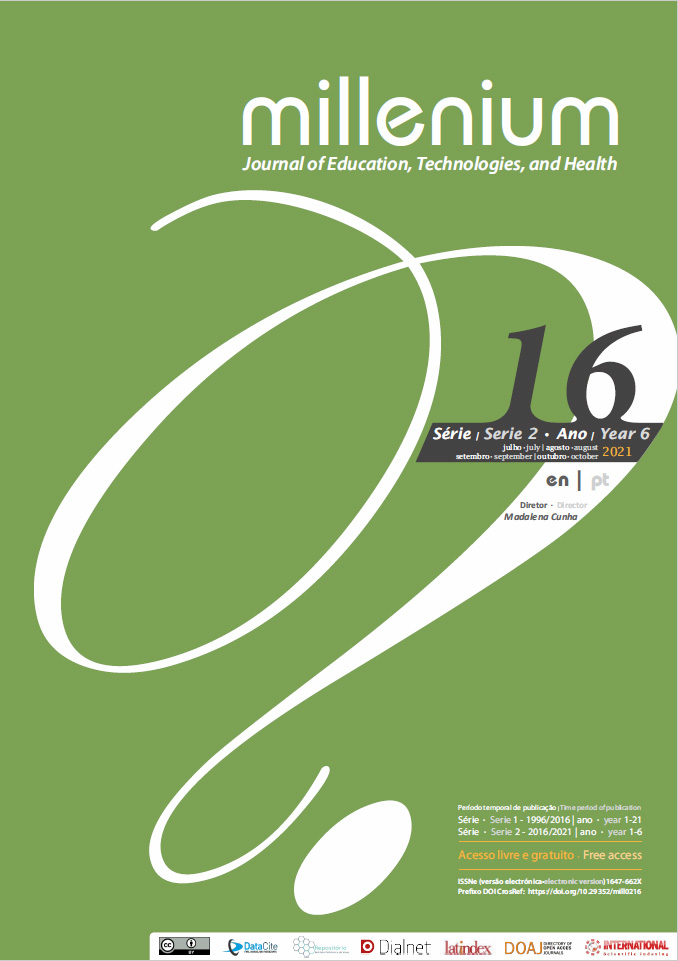Perceção dos enfermeiros sobre prática simulada em suporte básico de vida na prática clínica
DOI:
https://doi.org/10.29352/mill0216.24482Palavras-chave:
simulação, reanimação cardiopulmonar, enfermeirosResumo
Introdução: A prática simulada em suporte básico de vida permite aos enfermeiros desenvolver as suas capacidades para intervir num contexto de emergência, solidificando procedimentos e garantindo a segurança na prática.
Objetivo: Compreender a perceção dos enfermeiros sobre prática simulada em suporte básico de vida na prática clínica.
Métodos: Estudo quantitativo, descritivo e correlacional. Os participantes foram 612 enfermeiros de diferentes instituições de saúde em Portugal. Os dados foram adquiridos através de questionário online e analisados com recurso ao Statistical Package for the Social Sciences (versão 21) com estatística descritiva e inferencial, de acordo com a natureza das variáveis.
Resultados: O estudo demonstra que os participantes têm uma perceção positiva das competências desenvolvidas na sua prática clínica, com valores médios de 4.56±0.71 na compreensão do algoritmo de suporte básico de vida, bem como 4.52±0.76 por considerarem um excelente contributo para a prática clínica e 4.51±0.74 numa melhor capacidade de avaliação das vítimas.
Conclusão: A prática simulada é uma ferramenta essencial na formação inicial e contínua dos enfermeiros. A promoção de um plano de prática simulada adequado em suporte básico de vida para enfermeiros apresenta um impacto positivo na prestação de cuidados, indo de encontro às reais necessidades do doente em paragem cardiorrespiratória.
Downloads
Referências
Armstrong, P., Peckler, B., Pilkinton, C. J., McQuade, D., & Rogan, A. (2021). Effect of simulation training on nurse leadership in a shared leadership model for cardiopulmonary resuscitation in the emergency department. Emergency Medicine Australasia, 33(2), 255–261. doi: 10.1111/1742-6723.13605.
Buléon, C., Delaunay, J., Parienti, J.-J., Halbout, L., Arrot, X., Gérard, J.-L., & Hanouz, J.-L. (2016). Impact of a feedback device on chest compression quality during extended manikin CPR: a randomized crossover study. The American Journal of Emergency Medicine, 34(9), 1754–1760. doi: 10.1016/j.ajem.2016.05.077.
Chu, R., & Robilotto, T. (2018). Mock code training to enhance CPR skills. Nursing Made Incredibly Easy, 16(2), 11–15. doi: 10.1097/01.NME.0000529957.11904.8d.
Colquitt, J. D., Jr, Walker, A. B., & Haney, N. S. (2019). Applying the Pit Crew Resuscitation Model to the Inpatient Care Setting. Journal for Nurses in Professional Development, 35(1), E1–E7. doi: 10.1097/NND.0000000000000495.
European Resuscitation Council. (n.d.). Basic life support. https://www.erc.edu/courses/basic-life-support.
Everett-Thomas, R., Turnbull-Horton, V., Valdes, B., Valdes, G. R., Rosen, L. F., & Birnbach, D. J. (2016). The influence of high fidelity simulation on first responders retention of CPR knowledge. Applied Nursing Research: ANR, 30, 94–97. doi: 10.1016/j.apnr.2015.11.005.
Fraga-Sampedro, M. L. (2018). Simulation as a learning tool for continuing education on cardiorespiratory arrest. Enfermeria Intensiva, 29(2), 72–79. doi: 10.1016/j.enfi.2017.10.003.
Halm, M., & Crespo, C. (2018). Acquisition and Retention of Resuscitation Knowledge and Skills: What’s Practice Have to Do With It? American Journal of Critical Care: An Official Publication, American Association of Critical-Care Nurses, 27(6), 513–517. doi: 10.4037/ajcc2018259.
Herbers, M. D., & Heaser, J. A. (2016). Implementing an in Situ Mock Code Quality Improvement Program. American Journal of Critical Care: An Official Publication, American Association of Critical-Care Nurses, 25(5), 393–399. doi: 10.4037/ajcc2016583.
Kim, S.-O., & Choi, Y.-J. (2019). Nursing competency and educational needs for clinical practice of Korean nurses. Nurse Education in Practice, 34, 43–47. doi: 10.1016/j.nepr.2018.11.002.
Morton, S. B. (2017). Impact of High-Fidelity Simulation Training on Medicalsurgicalnurses’ Self-Confidence & Mock Code Blue Performance: A Pilot Study (Doctoral dissertation). Obtained from https://ninercommons.uncc.edu/islandora/object/etd%3A1022/datastream/PDF/download/citation.pdf.
Portuguese Cardiology Foundation (n.d.). Statistic data. http://www.fpcardiologia.pt/atividades/projeto-salva-vidas/dados-estatisticos/.
Smith, L. R. (2017). Improving Cardiopulmonary Resuscitation Skills Using Unit Based Simulation (Doctoral project). Obtained from https://digitalcommons.gardner-webb.edu/cgi/viewcontent.cgi?article=1296&context=nursing_etd.
Sok, S. R., Kim, J. A., Lee, Y., & Cho, Y. (2020). Effects of a Simulation-Based CPR Training Program on Knowledge, Performance, and Stress in Clinical Nurses. Journal of Continuing Education in Nursing, 51(5), 225–232. doi: 10.3928/00220124-20200415-07.
Vincelette, C., Quiroz-Martinez, H., Fortin, O., & Lavoie, S. (2018). Timely Recognition of Ventricular Fibrillation and Initiation of Cardiopulmonary Resuscitation by Intensive Care Unit Nurses: A High-Fidelity Simulation Observational Study. Clinical Simulation in Nursing, 23, 1–9. doi: 10.1016/j.ecns.2018.07.005.
Whitmore, S. P., Gunnerson, K. J., Haft, J. W., Lynch, W. R., VanDyck, T., Hebert, C., … Neumar, R. W. (2019). Simulation training enables emergency medicine providers to rapidly and safely initiate extracorporeal cardiopulmonary resuscitation (ECPR) in a simulated cardiac arrest scenario. Resuscitation, 138, 68–73. doi: 10.1016/j.resuscitation.2019.03.002.
Więch, P., Sałacińska, I., Muster, M., Bazaliński, D., Kucaba, G., Fąfara, A., … Januszewicz, P. (2019). Use of Selected Telemedicine Tools in Monitoring Quality of In-Hospital Cardiopulmonary Resuscitation: A Prospective Observational Pilot Simulation Study. Medical Science Monitor: International Medical Journal of Experimental and Clinical Research, 25, 2520–2526. doi: 10.12659/MSM.913191.
Downloads
Publicado
Como Citar
Edição
Secção
Licença

Este trabalho encontra-se publicado com a Licença Internacional Creative Commons Atribuição 4.0.
Os autores que submetem propostas para esta revista concordam com os seguintes termos:
a) Os artigos são publicados segundo a licença Licença Creative Commons (CC BY 4.0), conformando regime open-access, sem qualquer custo para o autor ou para o leitor;
b) Os autores conservam os direitos de autor e concedem à revista o direito de primeira publicação, permitindo-se a partilha livre do trabalho, desde que seja corretamente atribuída a autoria e publicação inicial nesta revista.
c) Os autores têm autorização para assumir contratos adicionais separadamente, para distribuição não-exclusiva da versão do trabalho publicada nesta revista (ex.: publicar em repositório institucional ou como capítulo de livro), com reconhecimento de autoria e publicação inicial nesta revista.
d) Os autores têm permissão e são estimulados a publicar e distribuir o seu trabalho online (ex.: em repositórios institucionais ou na sua página pessoal) já que isso pode gerar alterações produtivas, bem como aumentar o impacto e a citação do trabalho publica
Documentos necessários à submissão
Template do artigo (formato editável)





